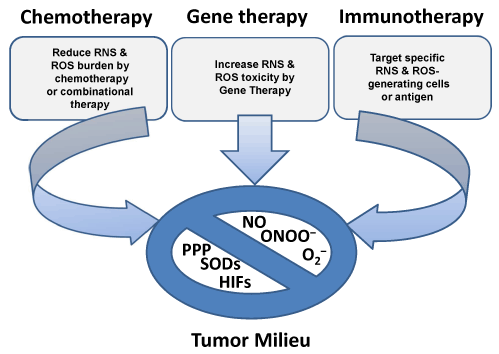
 |
| Figure 2: Strategies for modulating nitric oxide, peroxynitrite, and superoxide in tumor milieu for therapy: The figure shows the various targets in the tumor milieu for therapeutic intervention. Reactive nitrogen and oxygen species and peroxynitrite within the tumor milieu are necessary and collective contributors of tumor-mediated immune evasion.(3, 19). They may function independently or collaboratively depending on the biochemical event. The cancer cells have evolved into a metabolic state to not only tolerate, but reduce reactive free radicals and oxidative damage. This metabolic state is regulated by various biochemical pathways {e.g. pentose phosphate pathways (PPP)}, enzymes {e.g. superoxide dismutase (SOD)} and other factors {such as hypoxia-inducible factors (HIFs)} in the tumor milieu [17,56,57,71]. Several strategies have shown promising results in reversing immunosuppression by disrupting the roles of reactive nitrogen and oxygen species in tumors in animal studies and in man [56,57] These approaches include immunotherapy, gene therapy and chemotherapy [19,56,57,71]. Gene therapy targets the basic redox balancing processes. This approach is cancer-cell specific and it avoids collateral damage. Various chemotherapies and immune therapies reduce the levels of reactive nitrogen and/or oxygen species as secondary targets. Inhibitors of reactive nitrogen and or oxygen species have been used during Adoptive Cell Therapy or in vivo for preconditioning tumor microenvironment with other combinational therapies [19,46]. Another approach is by increasing the levels of endogenous nitric acid in tumors or introducing exogenous NO which sensitizes tumors to radiation therapy [19]. |